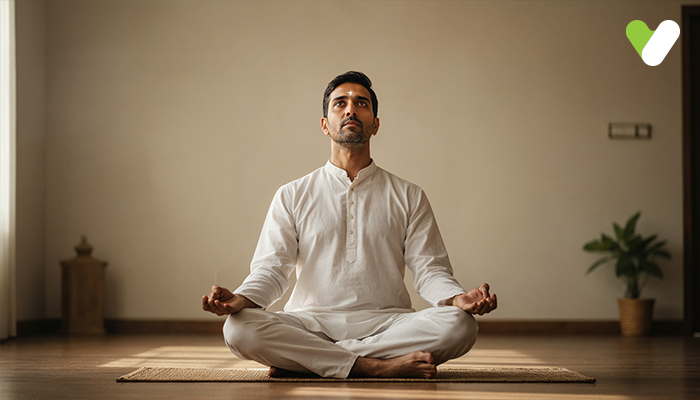Shambhavi Mudra is a yogic technique that involves gazing at a fixed point with the eyes closed while simultaneously engaging the breath and certain muscles in the body. There is a wide range of health benefits of Shambhavi Mudra, impacting physical, mental, and emotional well-being.
You can enhance your meditation technique by beginning to use the Shambhavi Mudra. You'll experience mental calmness when you adapt to this ancient practice. It is thought that the Shambhavi Mudra serves to awaken Kundalini Shakti from the Muladhara Chakra to the Third Eye Chakra, where Shambhu and Shambhavi are united so that it is synonymous with the Kundalini Shakti.
Many researchers have studied the health benefits of Shambhavi Mudra, and most of them have found it effective in multiple ways. By going through this page, you will understand the immense offerings of this yogic technique on our body as a whole.
Physical Benefits of Shambhavi Mudra
The Shambhavi Mudra benefits in terms of physical fitness are many. To check them out, read further.Boosts Immune System
The immune system is essential for maintaining good health, as it fights off harmful viruses and bacteria. Shambhavi Mudra may indirectly support immune function by reducing stress and promoting relaxation. Along with a nutritious diet and daily physical activity, such as yoga, practising Shambhavi Mudra may contribute to a healthy lifestyle and help build immunity.Shambhavi Mudra Benefits for Brain
Practising Shambhavi Mudra may lead to better integration between the left and right portions of the brain, resulting in increased creativity and flexibility. This integration may also increase brain coherence, allowing for faster signals from the brain and better coordination with other organs. Additionally, the practice of Shambhavi Mudra may result in lower stress levels.Benefits of Shambhavi Mudra Kriya for the Eyes
Shambhavi Mudra may also strengthen the muscles that control vision, relieve pressure around the eyes, and potentially prevent eye issues. However, it is important to practise under a qualified trainer’s guidance and consult with a doctor beforehand to avoid any adverse effects.Improves Digestion
The mudra helps improve digestion by stimulating the digestive organs, such as the stomach, liver, and pancreas. This, in turn, helps to alleviate digestive disorders like constipation, indigestion, and bloating.Shambhavi Mudra benefits for the Nervous System
The regular practice of Shambhavi Mudra can aid in balancing the nervous system, making it advantageous for individuals who struggle with chronic pain conditions such as fibromyalgia or chronic fatigue syndrome. By incorporating deep breathing and meditation techniques of Shambhavi Mudra, such nervous system problems can be reduced. It also decreases the secretion of stress hormones and encourages a peaceful and relaxed state.Solves Menstrual Problems
Menstrual health is a critical concern for women, as it can lead to various issues such as PCOD and PCOS. These problems can have social and psychological impacts on an individual's life. While contraceptive tablets are often prescribed to manage menstrual health issues, they can negatively impact fertility in the long run. A lifestyle change is recommended as the primary treatment for such conditions, and incorporating practices like Shambhavi Mudra into a regular routine is recommended by medical experts.Relieves Headaches
The regular practice of Shambhavi Mudra helps reduce tension in the forehead and eyes, which can alleviate headaches and migraines.Regulates Blood Pressure
Shambhavi Mudra has been found to be effective in regulating blood pressure levels, which is beneficial for people with hypertension.Enhances Lung Capacity
The mudra aids in improving lung capacity by encouraging deep breathing, which is essential for good respiratory health.Increases Energy Levels
Shambhavi Mudra is known to increase energy levels by improving blood circulation, oxygenation, and nutrient absorption.Mental and Emotional Benefits of Shambhavi Mudra Kriya
One among the major Shambhavi Mudra benefits is that it stimulates the Ajna Chakra, also known as the third eye, which is believed to be responsible for intuition, perception, and foresight. The stimulation of this chakra leads to an increase in mental clarity and sharpness, making it easier to concentrate and focus on tasks. The Shambhavi Mudra benefits in terms of Mental Health are as follows:Improves concentration and focus
Shambhavi Mudra is known for its ability to enhance mental clarity and focus through its meditation techniques. The practice involves sitting with the eyes closed, focusing on the gap between the eyebrows while keeping the breath slow and steady. This helps calm the mind, reduce distractions, and improve concentration. As a result, the practice aids in enhancing cognitive function and overall mental performance.Promotes better sleep
Shambhavi Mudra Kriya benefits can improve the quality of sleep by inducing deep relaxation. By reducing stress and promoting relaxation, Shambhavi Mudra can help individuals fall asleep faster and stay asleep longer. Furthermore, this practice may also alleviate the symptoms of insomnia and enhance overall sleep quality.Reduces stress and anxiety
Shambhavi Mudra is an excellent tool for reducing stress and anxiety by calming the mind and inducing a state of relaxation.Enhances memory
Regular Shambhavi Mudra practice has been found to enhance memory and cognitive function by improving blood flow to the brain.Alleviates depression
Shambhavi Mudra can effectively alleviate the symptoms of depression by promoting the feelings of well-being and reducing stress. The mudra helps boost self-confidence by promoting a sense of inner calm and clarity.Spiritual benefits of Shambhavi Mudra Kriya
When it comes to Shambhavi Mudra benefits in terms of spiritual enlightenment, it touches many facets of life, of which the integral ones are discussed below.• Heightens awareness and intuition
Shambhavi Mudra helps heighten awareness and intuition by promoting a deep state of meditation and inner reflection.• Facilitates spiritual growth
Regular Shambhavi Mudra practice is believed to facilitate spiritual growth by helping individuals connect with their inner selves and higher consciousness.• Deepens connection with the Divine
The mudra is known to deepen the connection with the divine by facilitating a sense of inner peace and harmony.• Purifies the mind and body
Shambhavi Mudra helps to purify the mind and body by releasing negative emotions, thoughts, and energy.• Enhances creativity and inspiration
The mudra helps enhance creativity and inspiration by promoting a state of mental clarity and focus.• Promotes inner peace and joy
Shambhavi Mudra is known to promote inner peace and joy by inducing a state of relaxation and inner calm.Advantages of Shambhavi Mudra for Children
Shambhavi Mudra Kriya benefits children and could potentially prevent pineal gland degeneration, which plays a crucial role in maintaining brain function along with hormonal balance. In addition, it may aid in the development of emotions among children above eight years of age. However, it is better to consult with a paediatrician or specialist before introducing this practice to a child.Steps of performing Shambhavi Mudra Kriya
Shambhavi Mudra is an advanced yoga practice that should ideally be learned under the guidance of a qualified yoga teacher. Here are the steps to practise Shambhavi Mudra:- Sit with your spine straight in a comfortable cross-legged posture, ideally in Sukhasana or Siddhasana.
- With your palms facing up and your hands upon your knees, make the Gyan mudra by touching the tip of your thumb to the tip of your index finger.
- When you shut your eyes, relax your face muscles, neck, shoulders, and the area around your eyes.
- Open both of your eyes slowly and fix your attention on an eye-level spot on a wall in front of you.
- Roll your eyes upward and inward, focusing on the centre of your brows while keeping your head steady.
- Hold your gaze at this point for a duration comfortable without blinking or moving your eyes.
- When you feel strain or discomfort, shut your eyes while taking a break. You can also rest your palms over your closed eyes.
- Shut your eyes and try to quiet your mind by concentrating on the serenity of the darkness hidden behind them. With regular practice, you can gradually increase the duration and number of rounds of Shambhavi Mudra. Remember to practise Shambhavi Mudra with caution and under the guidance of a qualified yoga teacher, especially if you have any medical conditions or eye problems.
What Distinguishes Shambhavi Mudra from Shambhavi Mahamudra?
Shambhavi Mudra and Shambhavi Mahamudra are similar practices with slight differences. The basic Shambhavi Mudra involves focusing on the centre of the eyebrows and is a contemplative practice without any additional techniques. On the other hand, Shambhavi Mahamudra is a more advanced practice that involves a specific sequence of various yogic practices to attain a higher level of consciousness. While Shambhavi Mudra is referenced in ancient texts such as the Vigyan Bhairav, Rudraya Mala Tantra, Hatha Yoga Pradipika, and Shiva Samhita, there is no traditional source that specifically mentions Shambhavi Mahamudra.When to Avoid Shambhavi Mudra?
At certain times, you should avoid practising Shambhavi Mudra. The conditions in which you must avoid it are given below:- Stop practising the Mudra if you have a feeling of discomfort in your eyes, as it is a delicate sense organ.
- Before practising Shambhavi Mudra, people with diabetic retinopathy and glaucoma should consult a doctor.
- If you previously have undergone any optic surgery, any lens implant, or any other eye procedure, then consult your doctor or yoga instructor before doing Shambhavi Mahamudra.
Influence of Shambhavi Mudra on Energy Channels of the Body
Shambhavi Mudra involves focusing the gaze and concentration on the centre of the eyebrows, which is believed to be an extraordinary point according to the theory of Chinese meridians. This point is known as Yintang, which means ‘seal of the hall’ and is associated with the space where Chitta (inner consciousness) resides. The practitioner can access and experience their inner self by meditating on this point.Stimulating the muscles around the eyes during Shambhavi Mudra also activates points in the urinary bladder, stomach, and gall bladder meridians. These points are commonly used in acupuncture to treat various eye disorders and muscle issues. Additionally, the movement of the eyeballs during practice stimulates a branch of the heart meridian that runs from the heart to the eye, which can help regulate emotions and increase awareness.
According to Chinese meridian theory, the liver controls the eyes, and the eye opening reflects the liver's state. By positively influencing the liver through the eyeball movements during Shambhavi Mudra, the flow of energy throughout the body is stabilised, leading to overall balance and improved functions of the eyes. The practice of Shambhavi Mudra also balances the three doshas within the body, as described in Ayurveda, and helps balance the block pitta located in the eye, positively impacting the thought process.


